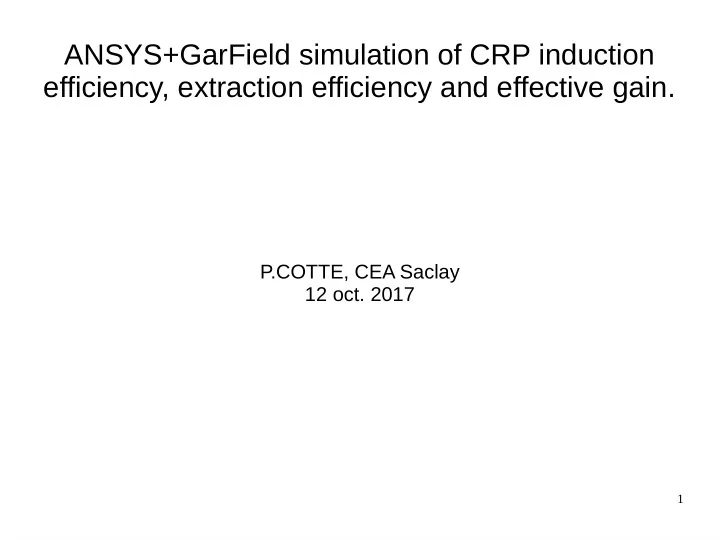

ANSYS+GarField simulation of CRP induction efficiency, extraction efficiency and effective gain. P.COTTE, CEA Saclay 12 oct. 2017 1
Content ● ANSYS geometry ● GarField input parameters and Microscopic traking ● Definition and results of efficiencies and gain ● Conclusion 2
LEM hole geometry Base element in ANSYS simulation 3
ANSYS Geometry : simple with symmetry conditions on borders Grid ( considered as a plane) Symmetry conditions on border Anode give full hexagonal geometry (considered as a plane) 4
GarField input parameters ● Pressure = 760 Torr ● Temperature = 87K ● 100 % Argon 5
GarField simulation ● Electron starting point : just above liquid (GarField does not simulate drift in liquid) ● Drift and avalanche method : microscopic tracking, uses scattering rates and cross sections to simulate various kinds of collisions ● Also simulates photons emissions and their ionising effect 6
Example with anode=0V, LEM top=200V, LEM bottom = 3000V, Grid = 5500V Starting point FR4 liquid Extraction zone Induction zone 5 (=LEM) (gas) 1 3 Bottom copper 2 Top copper 4 Anode 3 4 1 5 2 Electron startpoints 5 3 1 1 Electron 2 4 endpoints 7
Relevant values and their definition ● Induction efficiency = electron at anode / electrons exiting amplification zone (main loss is on top copper) ● Extraction zone transparency = electrons reaching amplification zone / electrons generated (main loss is on bottom copper) !!! only in gas !!! ● Total extraction efficiency = transparency convoluted with liquid-gas extraction efficiency ● Effective gain = electrons at anode / electrons generated Does not take charging up 8 into account!
Nominal voltage 2500V : Transp. = 0.7 9
Total s a g n i e g a t l o v = ! d i u q Nominal voltage 2500V : Extr. Eff. = 0.68 ± 0.07 i l n i e g a t l o v t a h t t c a f e h t t n u o c c a o t n i e k a t t o n d i D 10 → We should be able to divide extraction voltage by 2 without loosing efficiency ! Can it be checked in the 311 ?
Now it does : efficiency is a bit lower Nominal voltage 2500V : Extr. Eff. = 0.58 ± 0.07 → Diminishing Grid-LEM voltage will significantly diminish efficiency. 11
Optimal voltage 1000V Ind. Eff. = 0.7 Currently used voltage 200V Extr. Eff. = 0.32 (3L) 12
Effective gain : simulation of 3L and comparison to measurements Pressure set to 735 Torr to match experimental conditions Simulated gain ~ one third of measured gain => Measurement were done before charging up : should be equal to simulation Possible explanations : - GarField microscopic tracking not reliable for avalanche? → try other simulation methods (next slide) - Should consider possible photoelectric effects of UV going back to hit the grid, producing more electrons, increasing gain? → in progress 13
3L simulation with Garfield’s MC method Still a big discrepancy between data and simulation 14
3L simulation with Garfield’s MC method MC method Microscopic tracking method None of the two methods fit the data. 15
Conclusion ● Extraction and induction efficiencies simulated, can be added to simulation and reconstruction software ● Could check the total extraction zone efficiency at lower extraction voltage on the 311 ● Simulated gain is not coherent with measurements, needs more investigations 16
Induction efficiency when keeping the ratio of voltages induction/amplification constant Simulation of Saclay’s HP Chamber when amplification voltage = 6 x induction voltage : Efficiency is constant 17
Recommend
More recommend